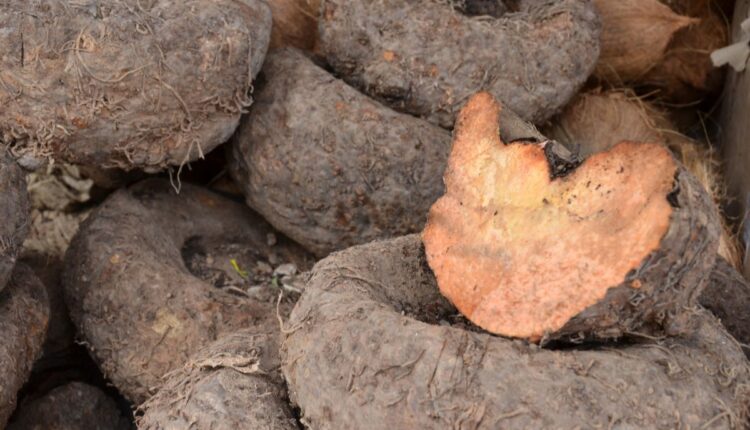Cultivation of Suran: Suran Ki Kheti: Suran or Yam is eaten as a vegetable in different parts of the country in the name of Ol and Jimikand. Suran is also called Elephant Foot Yam. Its vegetable is very tasty after being prepared. It also has many medicinal benefits. Its scientific name is Amorphophallus campanulatus. Earlier, sowing of Suran was limited to kitchen garden, land around the house. In today’s time, farmers are earning lakhs by cultivating it. It has a huge demand abroad. Many types of medicines are also made from Suran. If farmers cultivate it in one acre, then they can earn a profit of four to five times their cost. There are many varieties of yam which are cultivated in India.
When is yam cultivated?
The most important thing to grow yam crop is to know its correct method. With the right technique, farmers can earn lakhs by cultivating it. The cultivation of yam or jimikand is done from April to the end of June. If the farmer has irrigation facilities, then yam can be sown in the month of March as well.
Farming Technique Of Suran
Sandy loam soil is beneficial for yam cultivation. For the cultivation of ole (Suran Ki Kheti), farmers need to focus on the right and good tubers which can be used in sowing. If the farmer wants, he can easily plant yam in some parts of his field. To grow yam crop, first of all plough the field well. This helps in better transplantation. After the moisture is removed from the soil of the field, plough the field again with a rotavator. After this, put cow dung manure in the field at the rate of per hectare and level the soil.
Treatment Before Sowing of Suran
It is very important to treat them before sowing. For this, dissolve 5 grams of Emisan and 0.5 grams of Streptomycin in one liter of water and soak the tuber of Suran for about 30 minutes to 35 minutes. Remove it from the solution and leave it to dry. After this, dissolve two grams of Carbodizim powder in one liter of water in the cow dung solution and soak the tuber in it. Start planting it in the fields only after it dries again.
Irrigation and Weeding in Suran Farming
Prepare a drain at every two feet in the field and put compost manure in it. After this, put small tubers of Suran at a distance of one foot and cover it with soil. Light irrigation should be done immediately after sowing. It is important to know that it requires only three irrigations. Irrigation is not required after June. Proper care and weeding is necessary for the size of yam to grow. After three to four months, the weight of one yam tuber becomes three to four kilos.
When is the yam crop ready?
The crop is ready for harvesting after 7 to 10 months of planting in the field. When the leaves turn yellow and start bending, then one should understand that the crop is ready. Great care should be taken at the time of digging, so that the yam tubers are not cut. All the tubers should be taken out of the soil and spread in a shady place to dry them. Small tubers should be dried and kept in airy rooms for the next sowing.
Safety Measures In Transportation
Suran tubers should be sent to other places only after placing them between paddy straw or dry banana leaves, otherwise there are chances of tubers getting spoiled.
Pests and Diseases in Suran
Beetle Disease
Suran plants often get affected by beetle disease. This disease occurs in twigs and leaves. To protect the plants from this disease, neem juice should be mixed with microzyme and sprayed on the plants.
Blight Disease
Blight disease also attacks the suran plants and destroys the crop. This disease is bacterial. Due to this, the leaves of the plant become light brown in colour. For this, spray Bobby Jaundice Window Stand.
Tobacco Bollworm Disease
Tobacco Bollworm Disease also attacks the suran and destroys the plants. After the leaves turn light brown, the plants start wilting. For tobacco caterpillar disease, prepare a solution of mancozeb copper oxychloride and spray it.
Yam Beetle
Yam beetles weaken the plants by eating the stems of yam. To prevent this, spray 2 grams of carboryl 50 WP medicine mixed in one liter of water.
Best Varieties of Suran
There are many varieties of yam. Here we are going to tell you about some improved varieties-
Gajendra Variety
Farmers in different parts of the country plant this variety. Gajendra is a local variety. Only one tuber is formed in it. The color of the tubers is light orange. This variety is grown the most in the country because it produces the most. The capacity of this variety is 80-100 tonnes per hectare.
Santaraganchi Variety
The pulp of the tubers in this variety is light yellow in colour. It causes a slight itching sensation while eating it. The yield capacity of this variety is 50 to 70 tonnes per hectare.
M-15 Variety
Another excellent variety of yam is M-15 which is grown in the states of South India. It gives a yield of 80 tons per hectare.
Sri Padma variety
The tuber of this variety does not have any itching. Its stalk is green in colour. With the help of this variety, the production is 40 to 60 tons per hectare.
Income From Suran Farming
About 200 quintals of yam can be produced easily in one acre of land. The maximum cost of cultivating yam in one bigha is five thousand to eight thousand. In Indian markets, yam is sold at the rate of 3 thousand to 4 thousand rupees per quintal.
Benefits of Suran
It is rich in vitamin C, vitamin B6, vitamin B1, folic acid and fiber. Minerals like magnesium, calcium, potassium, iron and phosphorus are present in this vegetable.
Medicines that cure diseases like dysentery, bloody piles, piles, asthma, lung inflammation are prepared from Suran.
Suran is used as a vegetable in homes. Different types of vegetables, pickles, chutney, chips and namkeen are prepared from it.
Subsidy in Suran Farming
The central and state governments are working to promote the cultivation of Suran. Many schemes are being run to increase the income of farmers. The Bihar government is running the Integrated Horticulture Development Scheme for farmers. Under this, farmers are getting subsidy for the cultivation of Suran. The state government’s ‘Intercropping Campaign’ is currently running in 12 districts. Farmers can apply online for this. Bihar government is giving 50 percent subsidy on yam cultivation. To take advantage of the scheme, farmers should log on to the official website https://horticulture.bihar.gov.in.
Under the Prime Minister Micro Food Industry Upgradation Scheme, a grant of 35 percent of the unit cost and a maximum of Rs 10 lakh is available for starting a small business to prepare chips, powder, chutney, pickle made from yam.
Contact details: If farmers want to share information or experiences related to farming with us, then they can do this by calling us on the phone number 9599273766 or by writing an email to [email protected] or by sending your recording. Through Kisan of India, we will convey your message to the people, because we believe that if the farmers are advanced then the country is happy.



